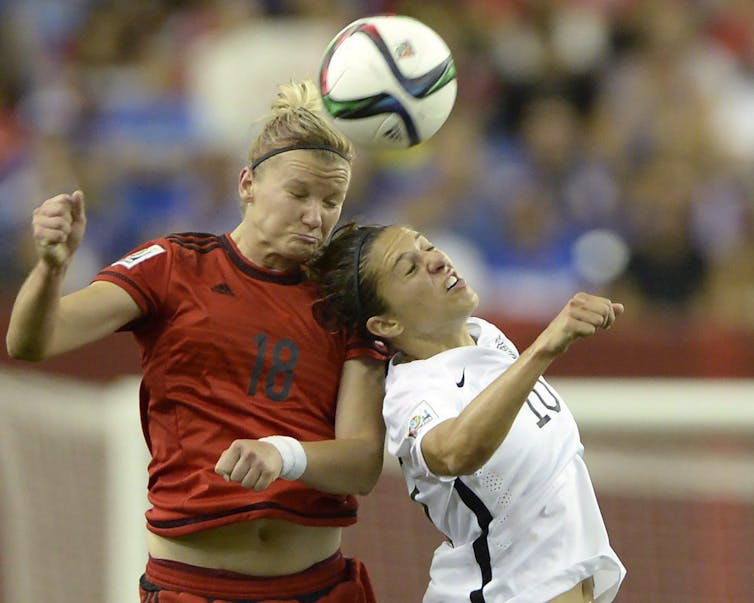
Dr. Owoeye is a clinician (physical therapist) scientist and currently a post-doctoral research fellow at the Sport Injury Prevention Research Centre, University of Calgary. His research focuses on the generation and implementation of knowledge that informs the prevention of sport-related injuries and consequences in youth and young adults. He has over 20 peer-reviewed scientific papers in top orthopedic and sports medicine/physical therapy journals, mostly relating to soccer (football) and basketball injury prevention.
We love “the beautiful game.”
Exciting times are here again. The 2018 World Cup in Russia brings the best teams and players from around the globe to compete for the most famous trophy in the world. (And as was just announced, it’s coming to Canada, the United States and Mexico in 2026.)
Do you play or know someone that plays soccer (or football, as it’s known outside of North America), either recreationally or competitively? Or perhaps you just love to watch the beautiful game? For me, it is a “yes” to both questions, including a commitment to the science and medicine of soccer.
Engagement in soccer is always fun, whether as a player or as a spectator. However, it only stays fun for as long as it stays safe.
Exercising regularly is challenging for many people, either because of a lack of motivation or time. This means many people take up sports — a more enjoyable and sustainable way of getting the weekly physical activity recommended by many national guidelines and international health organizations.
The many health benefits of soccer
Soccer is a high-intensity contact sport involving endurance, running and frequent changes in direction. Participation in soccer has many benefits including socio-economic and health benefits.
Taking part in recreational soccer has been shown in a recent study to have multiple broad-spectrum health benefits, including improved blood pressure, resting heart rate, blood cholesterol (low-density lipoprotein) and fat mass.
Read more:
How to prevent injury from sport and exercise
Unfortunately, regular participation in soccer exposes individuals to the risk of injuries. Once an injury occurs, the likelihood of reoccurrence is high.
Furthermore, most injuries resulting in medical attention and loss of time have long-term health consequences — including post-traumatic osteoarthritis of the knee and ankle joints.
Chance of injuries are high
How often injuries and concussions occur in soccer varies, depending on sex, age, level and continent of participation.
Current evidence shows the incidence of injuries to be high among soccer players. Specifically, injury risk is higher in males than in females and in games than in practises. There are also more injuries during adult tournaments than during youth tournaments.
Conversely, more injuries happen during training in male elite youth than in male professional adults.
The incidence of concussion in youth soccer is low across all levels of soccer participation. A higher concussion incidence has been consistently reported in females. Although they don’t happen very often, the consequences of a concussion can be severe if not properly managed.

THE CANADIAN PRESS/Ryan Remiorz
Common injuries in soccer include ankle, knee, hamstring and groin injuries. Certain factors have been identified to influence the risk of injuries in soccer, including poor balance, poor strength in the lower legs, improper landing technique, having a higher body mass index (BMI) and history of lower limb injury.
Most of these factors are modifiable and they present opportunities for injury prevention.
How are injuries prevented?
There are evidence-informed resources available online to help people stay active and safe while playing soccer.
Specific injury prevention strategies include risk pattern recognition, training/practice load optimization, strength/neuromuscular training programs such as the 11+ warm-up (available on YouTube), proper equipment use and timely concussion management.
Unfortunately, even with proper prevention, there’s no guarantee a player won’t be injured.
Accurate diagnosis and careful injury management protocol are the best ways to prevent an injury from reoccurring.
There is an ongoing effort to understand the best rehabilitation practices for specific injuries, including when someone with an anterior cruciate ligament (ACL) injury should return to play.
Are you ready?
There is also emerging evidence for new strategies to prevent long-term health consequences of soccer injuries — such as post-traumatic knee and ankle osteoarthritis years after a significant knee or ankle injury in youth sport.
The health benefits of participating in soccer are huge. The risks of injury are also high and the consequences are a big deal. Nonetheless, the health benefits of regular participation in soccer far outweigh the risks.
To stay active in this beautiful game and keep your health goals, you need to stay injury-free as much as possible. The challenge is to adopt and maintain these injury prevention strategies. There is ongoing research to understand implementation and behaviour change challenges among injury prevention end-users. This will hopefully drive better uptake and adherence to soccer injury prevention programs for the best public health impact possible.
![]() Before you engage in your next soccer practice or game, be sure you have taken all possible injury prevention protocols, including avoiding a training load spike and doing a structured warm-up exercise.
Before you engage in your next soccer practice or game, be sure you have taken all possible injury prevention protocols, including avoiding a training load spike and doing a structured warm-up exercise.
Oluwatoyosi Owoeye, Post-Doctoral Fellow, Sport Injury Prevention Research Centre, University of Calgary
This article was originally published on The Conversation. Read the original article.
![]()